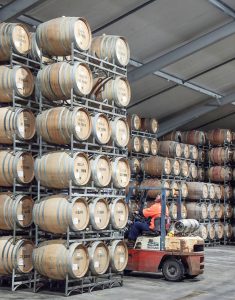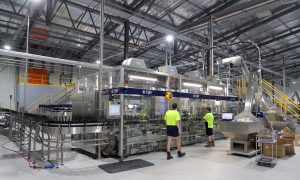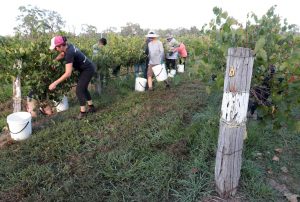Unifying the team
Image courtesy Hunter Valley Wine and Tourism Association
By Ilga Horvat
As part of her ongoing series providing tips to grape and wine business operators, Ilga Horvat from Boutique HR Consulting, looks at effective team-building ahead of the upcoming vintage.
As we are nearing Christmas and coming into the busiest quarter in the grapegrowing and winemaking calendar, I thought it timely to write about unifying your team. Harnessing a positive and resilient team dynamic is crucial for the next few months of multiple priorities, hard work, and urgency.
Last month I wrote about ‘Mastering the Art of Feedback’ and using this to create an effective relationship with your team members. This is one of the tools to create an empowered, engaged, and well-performing team.
When a feedback loop is created effectively a psychologically safe environment is created. This is an environment where team members feel they can speak up without negative consequences.
There is a lot of talk about this of late especially in light of the recently updated Psychological Safety legislation. We will explore more about this in future articles but it is important to touch on in talking about building a strong team. Team psychological safety has huge benefits. When a team collectively embraces shared beliefs and fosters an environment where individuals feel at ease and secure in voicing their ideas, concerns, questions, and acknowledging errors without facing adverse repercussions, their collaborative performance is enhanced. That is, together they achieve more.
Harvard Business Review, in their article “What is psychological safety?” highlights studies that concluded that positive impacts of team performance ensue when team psychological safety exists. Some of these are improved resilience, motivation and engagement. A referenced study was done by Google to understand the factors that impacted team effectiveness. This study concluded that “who was on a team mattered less than how the team worked together. And the most important factor was psychological safety.”
So, you can see how important that team dynamic is when you are managing your people through the busiest and most challenging periods.
The Christmas party is the perfect time to celebrate the hard work of the year behind us and prepare the team for the next few months. Sharing some laughs and camaraderie and getting to know each other in an out of a work setting is one way to create a stronger team.
Keeping engagement and motivation high
It can be challenging to keep engagement and motivation high during a long vintage period. Sharing what is going on and highlighting mini milestones you are working towards is a good way to keep everyone focussed. Communicating what is happening to everyone is important to create unity and engagement. Creating a visible planner with noted milestones is one way to do this.
Timing is crucial during the vintage period as it evolves, so conducting regular briefing sessions with the team would prove beneficial in maintaining their motivation. This is especially important when the team may have been working relentlessly with minimal time off for several weeks and are getting tired.
There is always someone who gets whingy and disheartened, however, if you have a team that is unified and focused, they will put a stop to that kind of talk. If that person’s mood doesn’t shift and negative talk continues then it needs to be addressed. If you have one member not functioning well it can be a risk to others. Feedback is important to manage this and reset their focus. It can be an opportunity to shift perspective and motivate or understand that the person may need some time out. Giving someone an opportunity to vent and be listened to may be all that is needed or there could be something serious that is occurring that you may need to consider.
Be mindful of tired team members. Tightly resourced teams may not be able to afford to give someone a day off when it is such a demanding season, however, after a rest we all work better and faster and with fewer errors.
The WH&S risks in the vineyard and winery when someone is exhausted and not as attentive can have serious consequences and involve much greater delays. This greater risk is not worth the short-term inconvenience of accommodating the time off.
Mistakes happen – build resilience and team psychological safety by using them to learn from. Wins should be celebrated, and mistakes or losses noted and learned from. Reset quickly and push the team to hit the next milestone.
The best sporting teams perform well and win games because the team is unified, trust each other, overcome obstacles, learn from mistakes and are resilient to push to that win.
In the spirit of unity and shared purpose it is important to remember, it’s not just about achieving goals and building a team, it’s about building each other up. Together, a great team has the power to conquer challenges, achieve greatness, and create a legacy of success.
As we approach the end of the year and embark on the last leg prior to harvest, make sure you take time to reflect on your collective learnings and achievements and raise a glass to team efforts.
I have my eyes on a fabulous vintage cuvee. Cheers!
More information can be found online: www.boutiquehr.com.au
This article was originally published in the December 2023 issue of the Australian & New Zealand Grapegrower & Winemaker. To find out more about our monthly magazine, or to subscribe, click here!
Are you a Daily Wine News subscriber? If not, click here to join our mailing list. It’s free!
Navigating the recent and upcoming Fair Work Legislation changes
Changes to the Fair Work Act will have considerable implications for wine industry employers. Ilga Horvat and Linda Blackett, from Boutique HR Consulting, provide insights into how business operators will be affected and how to respond and prepare accordingly.

Whether you have your own winery, vineyard or work in a wine-related role you will be affected by the recent changes to the Fair Work Act. The Fair Work Legislation Amendment (Secure Jobs, Better Pay) Act 2022 (SJBP Act) has staggered amendments and changes to a range of workplace laws. Navigating these can seem overwhelming when there are so many other considerations important to the day-to-day running of your business. However, if you manage people, there are some important changes you need to consider and perhaps do differently.
In this article, we will break down some of the main ones for you to review and the timing to action.
Pay secrecy, job ads, and flexible work
The following changes have taken effect already and coming into vintage or peak trading when you may increase your staffing, they are important to note.
Pay secrecy: From 7 December 2022 pay secrecy clauses no longer apply. Employees can freely discuss their pay and employment terms with others even if they have signed a contract that notes otherwise. From 7 June employment contracts can no longer include pay secrecy terms and employers who include them can face penalties.
Tip: Review your existing contracts and for any new team members, remove this clause. Be mindful of how you remunerate your team as people do talk. If you have a system where you have set accountabilities that are rewarded accordingly or open communication regarding performance and reward, then you shouldn’t have any issues.
If you don’t, you could have some disgruntled team members whose attention is on their employment conditions and taken away from what they were employed to do.

Job ads: From 7 Jan 2023 job advertisements cannot note pay that is lower than minimum entitlements. Now this may seem obvious, however, in this industry where piecework and period pay may apply, you could be in breach without realising it and have fines imposed.
Tip: If you are advertising a piecework style role where a periodic rate of pay applies, for example a rate of pay for the amount that is picked or pruned hourly or weekly, note this in the ad and include the rate of pay. These rates must not be lower than the award or industrial agreement applicable. See the end of this article on how to access an ad template for you to use as a guide.
Flexible work arrangements: A flexible work arrangement is where hours, place or pattern of work may be altered to suit an employee’s personal circumstance. From 6 June 2023 employers must consider requests from employees wanting flexible work. The list of staff eligible to request this has been extended to pregnant employees and employees or members of the employee’s immediate family or household who experience domestic violence. In summary, eligible workers already included employees who:
- Are 55 or older
- Are a carer
- Are a parent or have responsibility for a child
- Have a disability
- Are experiencing or providing support to an immediate family or household member experiencing family and domestic violence
- Are pregnant
- If casual, have been working regularly with the employer for 12+ months or have a reasonable expectation of continued regular work.
This does not mean that an employer has to agree to a request, but they do need to show that they have considered it. This means having a conversation, consider how refusal will impact the employee, genuinely look for ways to accommodate the request and respond to the request in writing within 21 days.
The Fair Work guidelines note that employers can refuse a request based on reasonable business reasons, for example; the arrangements are too costly or will result in a significant loss in efficiency or productivity or negatively impact customers.
Tip: If you receive a request from a staff member, be reasonable in your request and consideration to approve or deny. Ensure you have a conversation and discuss various options including considering the reasons for the request and the impact on both parties. Consultation is key and ensure you document the request and response.

Fixed-term contracts: To improve job security the SJBP Act has limited the use of fixed-term contracts. This change is anticipated to take effect from 6 December 2023 unless an earlier date is set in the coming months.
To quote the Fair Work Ombudsman, from this date “employers can no longer employ an employee on a fixed term contract that”:
is for 2 or more years (including extensions)
may be extended more than once, or
is a new contract:
that is for the same or a substantially similar role as previous contracts
with substantial continuity of the employment relationship between the end of the previous contract and the new contract, and either:
the total period of the contracts is 2 or more years,
the new contract can be renewed or extended, or
a previous contract was extended.
Employers must not take certain actions to avoid the new restrictions from applying. For example, they cannot:
delay re-engaging an employee for a period
re-engage the employee and engage someone else instead to do the same or substantially similar role.

How could this affect you?
Any employees that are on a fixed-term contract that breaches the new provisions will be considered a permanent employee regardless of the contract expiry date. This means the employee will gain access to entitlements such as termination and redundancy payments and access to unfair dismissal proceedings.
There are exceptions to allow some fixed-term contracts when genuinely necessary; for example in the case of apprentices or trainees, those undertaking essential work during a peak period or fixed period such as harvest or in replacing an employee on a long leave period. If they earn above the high income threshold they are also exempt.
These changes only apply to contracts that start after the legislation takes effect. However, any contract in place prior will be counted towards the set limits on number and length of contract.
Tip: Review any current or upcoming fixed-term contracts for recurrence, length and requirement and in turn, validity. Consider transitioning any long-term contract holders to permanent positions or reviewing roles to redefine duties. Ensure you provide any new fixed-term contract employees with a “Fixed Term Contract Information Statement”.
Gender equality
Anti-discrimination: Anti-discrimination legislation has existed for a while with strict guidelines on treating all people equally no matter their age, sex, race, sexual orientation, family or carer responsibilities, religion, pregnancy, etc. Employers are prohibited from taking any adverse action against their staff due to any of these (as well as other specified attributes). What does this mean exactly? It means that an employer may face penalties if they threaten or treat an employee or prospective employee in a way which causes an employment disadvantage based on these attributes.
From the 7 December 2022 this list has been expanded to include breastfeeding, gender identity and intersex status.
Tip: Ensure that your recruitment process is standardised and selection is based on skills and capabilities not on arbitrary factors. Ensure you have a clear anti-discrimination and anti-bullying policy that all employees are aware of. Training in this area is increasingly important and will ensure from the start you instil a culture of fairness and respect. This could mean as part of your staff onboarding, a simple training video or an interactive session outlining what behaviours are and are not acceptable in the workplace.
Bullying: Bullying is also part of the updated discrimination legislation. It highlights the Fair Work Commission (FWC) has an active role in stopping bullying. Bullying occurs when a person or group of people repeatedly behave disrespectfully or unreasonably towards others in the workplace and/or cause risk to their health and safety (physical and mental).
Workplace laws actively prohibit bullying as does Work Health and Safety legislation. This has also recently been updated to ensure a reduction of psychosocial hazards in the workplace. Employers have a duty of care to protect their staff from physical and psychological hazards. A failure to do so may incur penalties. The extent of these is governed by state legislation.
Sexual harassment in the workplace: From the 6 March 2023 the Fair Work Act has been updated to prohibit sexual harassment in connection with work. From this date, a person who experiences sexual harassment in connection with their workplace (including a representative association of the workplace) can take civil proceedings if their dispute cannot be resolved by the FWC.
The new legislation highlights that the employer is liable for the behaviour of any employees or agents in connection with the workplace unless they can prove they took all reasonable steps to prevent sexual harassment from occurring at work. This change has been widely covered in the media and in turn, there is little excuse for an employer to not do all they can to prevent such behaviour.
Tip: Update and recirculate your sexual harassment and bullying policy. Ensure as part of onboarding your staff that you include this topic highlighting what sexual harassment is and what behaviours constitute bullying. Note that this type of behaviour is unacceptable and what an employee should do if they experience this. This should follow from your anti-discrimination training and policies but should also be highlighted separately to ensure due focus.
Include it with your on-site safety induction briefing for all contractors to ensure that everyone connected to your workplace is fully briefed about safety and guidelines for expected respectful and acceptable behaviour.
This does not require elaborate and day-long training sessions. It can be straightforward. I have included some helpful links to get you started if you do not have anything in place.
Unpaid parental leave changes: From 6 June 2023 employees can request to extend their parental leave with a requirement for employers to respond to these. Similar to flexible work request updates, employers need to discuss and consider the request and only refuse on reasonable business grounds. The employer is to try to reach an agreement about the extension with the employee and consider the consequences of the refusal. A written response is required noting the reasons for refusal and include reference to the FWC dispute resolution provisions.
Tip: Be mindful of these changes and ensure you openly consult with your employees and consider all options before responding to the requests. Open dialogue is the key. Respond within 21 days.
The FWC has been open to note they have a directive to ensure when reviewing any cases brought before them they safeguard job security and gender equality. This is also the case when reviewing terms and conditions set by awards. At the risk of sounding repetitive, it is important to highlight that as an employer you also need to consider these aspects in your employment practices.
There are more changes concerning enterprise agreements and bargaining laws and a few others. The full list can be accessed on our website:
www.boutiquehr.com.au
Here you can access and download fact sheets covering the changes detailed as well as a handy timeline and checklist. We have also added templates for ads.
We will be covering practical people management topics in future issues of Grapegrower & Winemaker. If there is something in particular that interests you, please let us know at hello@boutiquehr.com.au or email the editor of this publication.
This article was originally published in the October issue of the Australian & New Zealand Grapegrower & Winemaker. To find out more about our monthly magazine, or to subscribe, click here!
To view the current issue of the Grapegrower & Winemaker, visit our Current Issue page.
Endeavour Group appoints new Chief Financial Officer
Endeavour Group Limited has announced Kate Beattie will be appointed as Chief Financial Officer (CFO) from 26 June 2023 as current CFO, Shane Gannon steps back from executive roles.
Beattie has held finance leadership roles within Woolworths and Endeavour Group for the past five years, commencing as Finance Director for the Retail Drinks division of Woolworths, prior to becoming Interim CFO of Endeavour Group leading preparations for the demerger, and Deputy CFO following demerger. Learn more here.
Get ahead of harvest labour shortages
Today’s labour shortage is predicted to continue into the upcoming 2022 harvest season.
Savvy winemakers are looking for ways to save time and resources while maintaining the high quality standards they demand for their craft. Using yeasts that can be pitched directly into the must allow one to eliminate the time-consuming inoculation process, skipping both the rehydration and acclimatisation steps without compromising fermentation or wine quality. Learn more here.
COVID restrictions leave producers short on seasonal workers
The ongoing effects of the pandemic have caused the emergence of labour hire issues for the wine industry on both sides of the Tasman. Stephen O’Loughlin looks into the impact on seasonal staffing and how this is likely to be addressed for next year’s vintage.
Lengthy border closures and state lockdowns have had major impacts on the staffing of wineries and vineyards for both employer and employee across the course of the past two years.
And while it is planned for all states to open their borders by Christmas, once the country is at 70-80% vaccinated, it is still unclear how movement between regional areas will function when this does occur.
In 2020, the New South Wales wine industry suffered greatly from a lack of skilled and semi-skilled workers right across the wine sector from people working in vineyards, pruning in winter, managing the growing season in spring and summer, and then picking at vintage time to people working in the winery, again particularly vintage staff to people working in tourism such as in cellar doors.
It is believed that the shortfall in just vintage staff in wineries and vineyards alone in NSW was as high as 1000, which was largely affected by the reduction in overseas travel.
No longer were we seeing backpackers filling the semi-skilled tasks, like picking and pruning, or those on working holiday visas undertaking more winery-based skilled roles, such cellar hand positions.
Wineries and vineyard owners got through primarily on their own or with limited local workers aiding them to still make this year’s vintage a successful one.
However, while it was hoped that things would be on the improve in 2021, they have unavoidably got worse with longer shutdowns, especially in NSW and Victoria, closing cellar doors and restaurants altogether and reduced numbers on site to actually produce the wine and maintain crops as well.
The remaining international workforce returned home or has been attempting to leave and thus the domestic workforce has been stretched to it limits and very much sort after across all fields of the agriculture sector.
NSW wineries have managed the pruning season by redeploying existing staff from other areas of their business such as cellar door and winery production to work in the vineyards.
The lockdowns have also presented challenges getting contract pruners in, especially in the Greater Sydney area.
The Government has offered assistance packages, like the Seasonal Workers Program and Pacific Labour Scheme, but gaining access to these funding programs has been difficult for the winery and vineyard owners because these packages have required employees to be contracted for several months which does not fit in with the nature of the wine industry where people are needed for intense bursts at vintage and pruning, for example.
These schemes also require the employers to pay large fees for hotel quarantine which can be over $3,000 per person.
Further challenges have arisen by the restrictions on movement of people and machinery from interstate, particularly Victoria and South Australia.
The NSW Wine Industry Association has been working closely with its State Government through the Department of Primary Industries and currently has a weekly Horticulture COVID Working Group meeting to raise and, hopefully, address all of the industry’s concerns.
Executive officer of the NSW Wine Industry Association, Angus Barnes, said that it has certainly been beneficial to hear from both State and Federal Governments as well as other industries experiencing similar problems but, while some solutions have been implemented, the underlying issue of staff shortages has not been resolved.
The NSW Agriculture Minister, Adam Marshall, early last month did call for an East Coast Agriculture Labour Taskforce that would:
- Identify opportunities to provide flexibility in Commonwealth Pacific Mobility Programs to access workers and their movement within and across jurisdictions,
- Develop local initiatives and solutions to mobilise labour and equipment,
- Identify innovative tools, technology, processes and machinery that will automate systems to reduce the reliance on temporary labour,
- Identify skills, education and training gaps that will support industry into the future,
- Develop a roadmap to address structural and reputational issues in the sector, and
- Advocate on behalf of the east coast states on issues of national importance
At the same time, the NSW Farmers Federation released a 10-point plan for consideration around ongoing agricultural workforce requirements which requests the following measures to be implemented:
- Certainty for mobile workers
- Targeted communications campaign
- Coordination assistance
- Incentives to participate in agricultural work
- Localised initiatives
- Facilitate timely flow of international seasonal workers
- Create and deploy ‘harvest ready’ training and upskilling
- Assist agricultural businesses to strengthen COVID-19 mitigation measures
- Appropriate accommodation options
- Establish an Agricultural Seasonal Workforce Working Group
Meanwhile, actual changes that the NSW Wine Industry Association envisage coming out of the pandemic’s lockdowns include more mechanical harvesting due to labour shortages, increased costs of employing vineyard staff (which is up by as much as 40%) having to be passed on, and continued working closely with interstate counterparts, particularly in Victoria and South Australia, to bring about suitable agreements around the safe and simple movement of people and machinery, especially during harvest.
Looking ahead to 2022
It is also highly unlikely that overseas labour will be back for the 2022 Vintage either so it will involve getting by with locals once again.
The issue looking further ahead though will be about training, encouraging and employing the future labour force back into the wine and winegrape industry over the long term which the NSW Government is aware of and assisting with, through such programs as Agskilled 2.0, which offers free accredited training for all fields of agriculture, particularly in viticulture where the wine industry is concerned.
Across the other side of the country, the Margaret River wine region in Western Australia has not been adverse to similar labour constraints.
As is the case around the whole of the country, the region’s labour is a mix of locals, working holiday visa holders and seasonal workers and the significant reduction in those working holiday people has had the biggest impact this year.
Data has revealed that the number of people with working holiday visas in Australia has decreased by over 100,000 from the beginning of the pandemic in March 2020.
With reductions like that, it is no wonder that labour issues have been of major concern.
“It necessitated a lot of pre-planning and forecasting by the wineries to ensure harvesting could be achieved when required,” said Margaret River Wine Association chief executive officer Amanda Whiteland.
“Many were affected and called on anyone available to help with the harvest. Many wineries called on their cellar door staff, stranded travelers and retirees to assist with some hand picking this year.”
In New Zealand, it was very much the same story.
Any looming labour shortage around the forthcoming vintage is currently being addressed, looking at past experiences from this year’s vintage and assessing whether wineries and vineyards will need to seek out different means of staffing to get through the 2022 vintage or whether it will continue as normal.
“Supporting our members to attract sufficient seasonal labour will be the number one priority for New Zealand Winegrowers,” said New Zealand Winergrowers chief executive officer Philip Gregan.
“With borders unlikely to open and the traditional pool of backpackers dwindling, we expect seasonal labour to be the central issue to the industry’s ability to have a successful Vintage 22.
“Working closely with the horticulture sector, contractors and Government in the first quarter of 2021, we had the successful addition of 2,000 Recognised Seasonal Employer (RSE) workers through managed isolation and quarantine.
“A second cohort began arriving in July, to bring New Zealand’s total RSE workforce to just under 7,000 strong.
“The recent Government announcement that RSE workers from Samoa, Tonga and Vanuatu will be able to travel to New Zealand quarantine free is the result of significant work with officials and Government and will provide additional certainty for the industry to meet the coming seasonal tasks.
“We will continue to work with our regions, Government and stakeholders to ensure that they are aware of the likely shortages and the impact this will have on our members and supporting industries if they are not able to attract the workforce they need.”
Slim pickings for wine workers as sector refuses to be crushed
Labour shortages during wine vintage in South Australia are stretching beyond the vineyard as COVID restrictions prevent contributions from northern hemisphere winemakers who usually bolster the industry at this time of year. Source: InDaily
Award winners encourage more women in wine industry
Despite many Australian women enjoying in the occasional glass of wine, fewer dabble in a career within the industry, and viticulturist Sarah Collingwood wants to change that.
Her parents have had a vineyard for the past 18 years, but she did not start working full-time in the wine industry until seven years ago.
“Now John [my husband] and I haven’t left, and we hope we’re doing this for the rest of our lives,” she said.
Ms Collingwood said women only made up roughly 10 per cent of viticulturists and wine makers in Australia.
In an attempt to improve those numbers and recognise women in the field, earlier this week the 37-year-old was among 16 women invited to pour wines they helped create at a local Canberra bar.
The gathering marked the 2016 Women in Wine Awards, and Ms Collingwood was nominated as a finalist in the owner and operator category.
Despite not placing, she was the first woman in the region nominated for the award.
“I guess generally [the industry] is a bit unrepresented by women,” she said.
“Hopefully these awards are a good way to show women there are a lot of different roles in the wine industry and it’s a great industry to be a part of.”
From grape to glass at a small winery
According to Ms Collingwood, the wineries surrounding Canberra are best known for their shiraz and riesling varieties.
“The climate is just perfect for those grapes,” she said.
“The Canberra district is seen as a pretty small wine area, we’re not as big as the Barossa and Hunter and things, but we’re definitely up and coming.”
Ms Collingwood said she and her family shared a variety of jobs at their Four Winds Vineyard.
Her role consists of being a business manager and viticulturist, which involves studying grapes and deciding when to harvest.
Her sister and brother-in-law are the winemakers, while her husband manages the vineyard.
“It’s really labour intensive for us to get the grapes that we want at the end of the season,” she said.
“We probably pick 20 or 30 tonnes and we try and pick everything in one or two days so all the grapes start to ferment at the same time.
“The vines continue to grow until February or March with the riesling and then we handpick around then.”
The family all pitch in during the crushing and pressing process by stomping on the grapes, extracting the colour from the skins.
“We joke about the harvest weight loss program because everyone during harvest loses weight because it’s long hours and quite physical as well,” she laughed.
“It takes about six months for us to have a finished product with the whites and 12 months for the reds.”
Ms Collingwood said she would encourage more women to consider a career in the industry because it was such a supportive one.
“We often joke that if our tractor broke down there would be a line of tractors outside ready to help,” she said, smiling.
ABC RADIO Canberra – Sophie Kesteven
Have self-directed teams come of age?

Written on December 18, 2015
Source: http://www.hrmonline.com.au/
A 2012 Gallup survey of employee engagement in 142 countries showed that in Australia, 60 per cent of employees are dissatisfied with their work, while 16 per cent are actively disengaged.
In a bid to remedy this, organisations have instigated a range of employee engagement programs. But while such efforts often work in the short term, they have failed to deliver lasting results.
There’s a growing realisation that the problem is not with the employees – it’s the way organisations are structured. We are starting to see that in an information-rich world where people want fulfilment and even enjoyment in their work, the old pyramid-style hierarchical systems are failing both organisations and the people who work for them.
Add to this trend the attitudes and beliefs of the generation now entering the workforce: entrepreneurial, team-oriented, and authority-phobic, they prefer the shared economy of Uber and Airbnb. This cohort does not respond to positional power the way previous generations have. They know how to challenge power, and they will do it.
The solution, according to a new wave of management thinkers and CEOs, is to reinvent management altogether. It’s not the work or the workers that are the problem. It’s the way we manage both.
Some organisations have already taken a leap of faith and redesigned themselves using self-managed teams as the operating model. These new ways of working are not just an add-on. They require a wholesale reinvention of corporate decision making, processes and responsibilities. Their examples show that even large, complex organisations can operate on self-managed principles, and that the energy and potential that is unleashed is phenomenal.
Pioneers of the movement, the Management Innovation Exchange (MIX), an online community led by Professor Gary Hamel, talk about ‘hacks’ and ‘moonshots’ as they trial new ways of working. The MIX is sponsored by a network of strategic partners including Harvard Business Review and McKinsey & Company.
These early adopters show that, in general, the quality of work life and employee satisfaction (positive attitudes) are considerably higher, with consistent reports of significant reductions in costs along with increased productivity.
At Pfizer Pharmaceuticals, employees can outsource mundane aspects of their job without asking for permission. At a GE plant that assembles jet engines in North Carolina there is just one supervisor and 400 employees. Results have been so good that GE is rolling out this model in another 80 factories.
Under the leadership of Ricardo Semler, the highly successful Brazilian company Semco boasts an organisational chart that features concentric circles, representing autonomous, democratically run units that interact with each other. In just one innovation, Semco has done away with all restrictions on business travel. The caveat is that employees publish their expenses online where colleagues can view them. They are constrained not by the need for management approval or company guidelines, but by their peers.
The online music site Spotify has a flat hierarchy using autonomous eight-person ‘squads’. Each squad can choose what they want to work on, as long as they adhere to the internal company motto of ‘Be autonomous, but don’t sub-optimise’.
At California-based Morningstar, the world’s largest tomato processor, there are no titles and no promotions. Even with 400 full-time employees, no one has a boss and employees negotiate responsibilities with their colleagues. When decisions need to be made, they seek the advice of their colleagues before deciding.
Even the Australian Federal Police is moving away from a rigid paramilitary command and-control style to a focus on flexible, multi-skilled teams.
What can we learn from these pioneers? It’s easier to work with human nature than against it. And that employees can even enjoy work.



